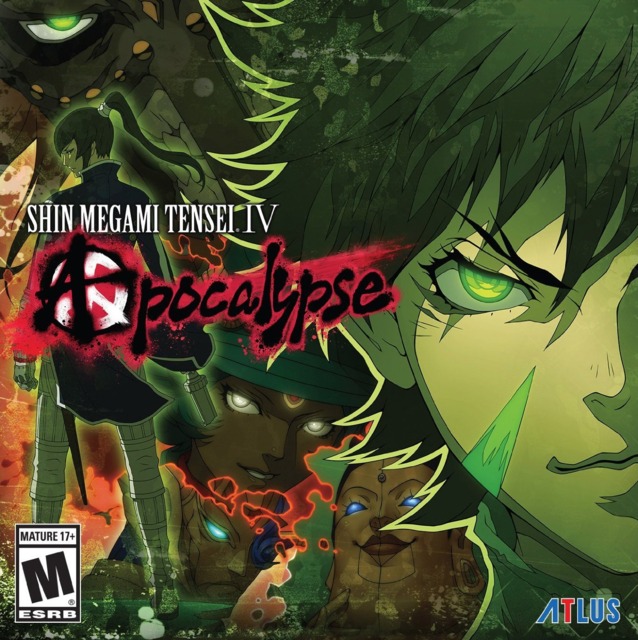Shin Megami Tensei 4 Apocalypse - Review
Shin Megami Tensei 4 was first released in the west almost three years ago. It was a great game. Its story was interesting, it offered a multitude of endings, and it played around with a lot of mechanics from older SMT titles to give them a bit of a modern spin. It didn’t really need a sequel, but here we are several years later with Shin Megami Tensei 4 Apocalypse. Calling is a traditional sequel would be a misnomer, though. Apocalypse is more like a retelling.
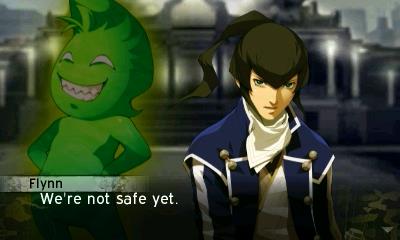
The events of the game start right before the climax of Shin Megami Tensei 4. Flynn, the hero of the original game, begins his march upon the angelic and demonic forces, while other hunters are doing what they can to support him. Your character and his troop of allies are out gathering supplies for the campaign when they are jumped by a small army of demons. You fall in battle after failing to fight them off. Your final moments are that of seeing your team massacred and your close friend, Asahi, slowly being surrounded by the demonic forces. Hope is not lost though and. In exchange for complete servitude, the rogue god Dagda is willing to grant you another chance at life. With little choice, you accept Dagda’s terms to save your friend, and must now work as his godslayer to help him reshape the collapsed world.
Apocalypse puts a lot of emphasis on its partner character system. In the previous game, partners felt like a bit of an afterthought. In battle, the game would cycle through available partners with each encounter and sometimes they’d work out and other times they’d constantly attack a boss with something they’re immune to. It was an annoying system that existed to make it feel like the NPCs traveling with you were the capable fighters the game hyped them to be.
In Apocalypse, you can choose your partner from a roster of characters you’ve recruited along the way. Each partner has their own unique set of gimmicks. The aforementioned Asahi is a healer but some of the other classes you can recruit are a buff and debuff support, a dedicated gun user, and an assassin with several 1-hit kill moves. Partners level with you, preventing them from becoming too weak to contribute. This overhaul gives a nice bit of leeway when trying to construct a team. You really don’t need to make one of your demons a dedicated healer if you can just use Asahi instead. Partners also generate a meter in battle that, once filled, will interrupt your opponent's turn and give you several benefits including stat buffs and healing.
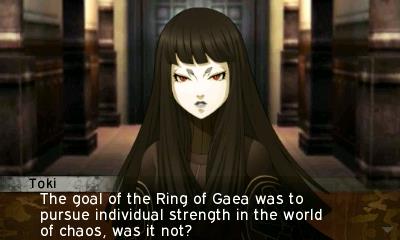
Partners also serve a larger part in the story. Apocalypse’s system of choice isn’t defined by certain NPCs representing the concepts of law or chaos like in previous SMT titles. Each character has their own little self-contained arc that’s slowly explored over the course of the game. A lot of cutscnes are also voiced, which helps give each character a broader range of emotion. There’s a pretty huge emotional difference that comes from reading what somebody says and hearing them, especially when actors add in small chuckles or groans not written in text. Apocalypse’s voice cast is pretty good, and each character fits the role well.
Unfortunately most of the cast don’t get the exposition that they needed. Despite solid acting and well written lines, a lot of times these characters’ stories feel rushed, or it makes little sense as to why they’re with you in the first place. Of all the partners, Gaston and Navarre have some of the best growth as characters. They both undergo a series of events that cause them to mature and change, but the rest of the cast can be summed up by a series of tropes with little or no actual change in their character. This is something that could have been improved upon by placing certain partners down certain routes, and only letting you encounter them that way.
Partners are only a small piece of your team though, as your main allies are the demons you can recruit and fuse. In a manner similar to SMT4 (and just about every SMT title before it), Demon partners are acquired by trying to negotiate with them out of random encounters. Negotiations can range from simply paying a demon enough money to doing a strange chain events to gain favor. Demons can then be raised to learn more powerful moves (which they eventually teach to you after learning all available skills), and fused to make new and stronger demons. This all creates a growth system with a lot of freedom. You can build your character and his demon partners in just about any way you want. It keeps things fresh and constantly has you on your toes to recruit and fuse new demons to continue gaining access to new skills.
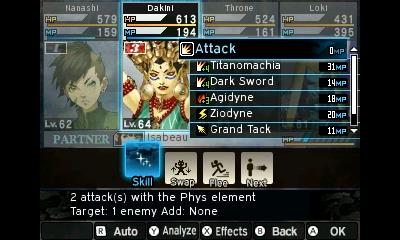
Combat stays in line with how it works in just about every other SMT title. You’re giving a certain amount of turns, represented by a series of icons, equal to the number of party active members you have. Exploiting a weakness or landing a critical hit gives you 1 extra turn and the potential to gain a condition called “smirk,” which makes your next attack a critical hit. Hitting an enemy with something they’re immune to results in you losing 2 turn icons, and possibly giving the enemy smirk instead. Enemies are also dictated by the same rules, and can gain and lose their turns as well. There’s a few new things added to spice combat up a bit from SMT4, such as moves that gain added benefits when your character has smirk status, but otherwise it’s roughly the same. On higher difficulties it’s a requirement to learn how to properly build a team and know how to exploit the AI to your advantage in battle to advance.
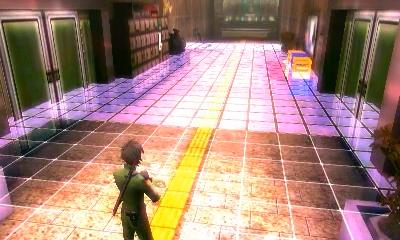
There’s not many new areas in the game. You end up retreading a lot of ground from the original SMT4, with maybe a handful of new locations. In order to try and make the old feel new, the development team stuck a bunch of barriers and roadblocks across the layouts of various levels, forcing you to take the long way around. This is probably the least enjoyable part of the game, as certain barriers can only be broken by a specific power up that comes on a timer. If the timer runs out you have to make your way back to the location you charged your weapon at and then try again. It’s not a hard task, but it is tedious and boring.
Overall, Shin Megami Tensei 4 Apocalypse feels more like a grand expansion than a new game. Despite the good 50 or so hours it took to complete, it never felt like I wasn’t playing more of the original Shin Megami Tensei 4. That’s not a bad thing, though. SMT4 was easily one of the best RPGs of 2013 and Apocalypse is one of the best for this year. If you played the original Shin Megami Tensei 4 and liked it, definitely consider picking up Apocalypse.
